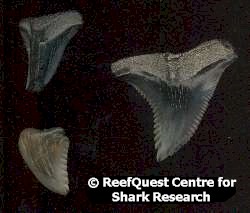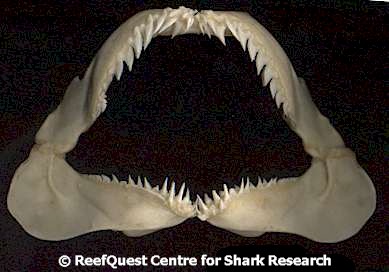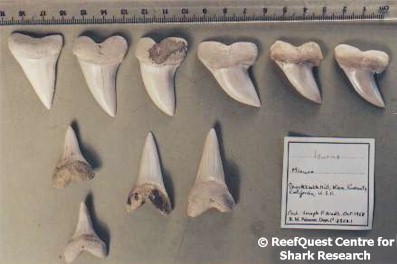Evolution of a Super Predator
Sharks are one of evolution's most enduring success stories. Although they have few hard parts that can survive the insults of geologic time, sharks have left a long and rich fossil record. Some 2,000 to 3,000 species of fossil shark have been described. In contrast, the total cast of the dinosaur dynasty comprises only about 650 to 800 species. The ancestry of sharks dates back more than 200 million years before the earliest known dinosaur. The dinosaurs are long gone now, canceled despite enthusiastic ratings (especially among the 8-year-old demographic). But we still have sharks - about 1,100 species of them. To understand the sharks as they are today, it is helpful to understand how their ancestors were in the distant past - where they came from, so to speak. The ancestry of modern sharks is an epic tale, as full of mystery and intrigue as any first date.
|
Sample of late-Cretaceous (about 65 million years old) sandstone from Texas, showing several fossilized shark teeth among fossilized mosasaur teeth, brachyopod shells, and various unidentified bits 'n' pieces. This sample shows how difficult it can be to pick out fossil shark teeth in the context of a fossil bed. |
 |
Fossil Shark Teeth
A 'fossil' is any remains, trace, or impression of ancient life, preserved in rock. Fossils include not only mineralized bones and shells, but also casts of footprints, skin, and even coprolites (fossilized dung). Unfortunately for paleontologists, the conditions that favor fossilization are very stringent. Fossilization requires both insulation from the destructive effects of microbes and a supply of soluble minerals to replace organic tissue. If these conditions are met, once-living tissue may be replaced, atom by atom, to create a cast in stone of the original structure. However, because these conditions are rarely met, most organic material simply dissolves and thus the fossil record is vexingly incomplete. Many clues are not preserved at all, and others only under the most extraordinary of circumstances. Most clues do not survive the insults of geologic time. Or they are so poorly preserved that virtually every feature that may be used to trace ancestry is lost.
 |
Two badly-eroded fossil teeth and one exceptionally well-preserved fossil tooth of Hemipristis serra. Note how much information (detail and context) has been lost in the poorly-preserved specimens. Some fossil shark teeth are so badly eroded they are as smooth and featureless as the blobs of glass that was ashore on beaches after a winter storm. Fortunately, many fossil shark teeth are moderately to very well preserved, making identification much easier. |
Shark teeth provide paleontologists an unusual suite of advantages and drawbacks. Collectively, sharks' teeth are among the most abundant of vertebrate fossils. They are mineralogically stable and are often preserved under circumstances that do not ordinarily favor fossilization. The structure of shark tooth blades consists of a matrix of minerals (hydroxyapetite) embedded in a protein (collagen). The protein portion of shark teeth is most commonly replaced with phosphates, often preserving fine details useful for identification and tracing ancestry.

Cleaned and dried jaws of the closest living ancestor of Hemipristis serra, the Snaggletooth Shark (Hemipristis elongatus). Most serious fossil shark tooth collectors also maintain a reference collection of jaws from extant species, a practical application of the dictum, "The present is the key to the past."
If a fossil tooth is well-preserved, it affords numerous characters that can be used to identify the species (or at least the basic taxonomic group, such as genus, family, or order) to which it belongs. But, just as glass may be worn smooth by wave and sand, fossil shark teeth may have taxonomically useful features (such as serrations or secondary cusplets) eroded away by geological activity. Another complication stems from the fact that, unlike glass, fossil shark teeth were once part of living creatures. From studies of modern sharks, we know that the teeth of a given species can vary with such factors as position in the jaw, growth stage, sex, reproductive state, geographic population, individual peculiarities, and malformities. It seems very likely that ancient sharks also displayed such dental variability.
 A deformed fossil tooth of Carcharocles
megalodon. Such deformities and natural variation, when not
recognized as such, have led to the premature description of numerous
"new species" and unnecessarily
confuse the already difficult task of classifying fossil sharks.
A deformed fossil tooth of Carcharocles
megalodon. Such deformities and natural variation, when not
recognized as such, have led to the premature description of numerous
"new species" and unnecessarily
confuse the already difficult task of classifying fossil sharks.
No matter how well preserved, individual teeth cannot display the full
range of variability in a given shark species. Very few collections
of fossil shark teeth include a 'natural set' - that is, a relatively
complete assemblage of teeth from a single individual.
Most fossil shark teeth are found as isolated specimens. From these, 'artificial sets' can be constructed, but the practice is a less-than-exact science, relying on subjective decisions based on many years' experience examining recent and fossil shark teeth.

Partially reconstructed set of fossil shark teeth. These specimens, at the British Museum of Natural History, were collected by Joseph Arndt at "Sharktooth Hill", California, in 1958. While this reconstruction may seem more-or-less reasonable, it is composed of teeth from two distinct species, Cosmopolitodus hastalis and Cosmopolitodus planus. Errors such as this plague non-expert attempts at reconstructing fossil shark tooth sets from isolated teeth, even if they were collected at the same time and place.
Because the rate of evolutionary change in sharks is very slow and gradual, it can be frustratingly difficult to determine where one species stops and another begins. There is no evidence of punctuated equilibrium (sudden 'jumps' in form) in the shark fossil record. Without sharp discontinuities, boundaries between named species are often made rather arbitrarily along a continuum of variation. Thus distinctions among some fossil sharks may best be considered 'chronomorphs' (forms within an evolving lineage) rather than biologically discrete species.
Given all these difficulties, it is very much to the credit of paleontologists that we know as much about the fossil history of sharks as we do.
